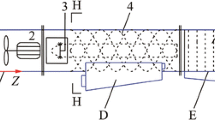Results are presented for an experimental study of the influence exerted on the effectiveness of an electrostatic cyclone by the initial concentration and inlet velocity of a dust aerosol with a high electrical resistance. The volt-ampere characteristics of the unit are also presented. Recommendations are given for optimal operating regimes.







Similar content being viewed by others
References
L. M. Novikov, V. T. Stefanenko, K. L. Novikov, and N. V. Inyushkin, “A new design of electrostatic cyclone for fine cleaning of gas,” Khim. Neftegaz. Mashinostr., No. 1, 37–40 (2011).
R. Tsai and A. F. Mills, “A model of particle re-entrainment in electrostatic precipitators,” J. Aerosol Sci., No. 2, 227–239 (1995).
K. S. Lim, H. S. Kim, and K. W. Lee, “Comparative performances of conventional cyclones and a double cyclone with and without an electric field,” J. Aerosol Sci., No. 35, 103–116 (2004).
Z. Xiangrong,W. Lianze, and Z. Keqin, “Particle tracking and particle-wall collision in a wire-plate electrostatic precipitator,” J. Electrostat., No. 63, 1057–1071 (2005).
L. A. Kushchev, Intensification of Entrapment of Solid- and Liquid-Phase Aerosols with Use of Force Fields: Dissert. Doct. Techn. Sci., Belgorod (2004).
V. A. Petrov, N. V. Inyushkin, and S. A. Ermakov, “Precipitation of dust particles in an electrostatic cyclone,” Vestn. TGTU, 16, No. 1, 44–53 (2010).
V. A. Petrov, N. V. Inyushkin, and A. A. Ermakov, “Effect of particle size and gas velocity on the precipitation of ash on the surface of the curvilinear channel of an electrostatic cyclone,” Khim. Tekhnol., No. 1, 34–38 (2010).
N. V. Inyushkin, S. A. Ermakov, A. G. Titov, et al., “Entrapment of fly ash in an experimental model of an electrostatic cyclone,” Inzh. Vestn. Dona [Electronic resource], No. 4 (2011).
N. V. Inyushkin, F. S. Yugai, Z. R. Gil’vanova, et al., “Precipitation of sodium percarbonate crystals in an electrostatic cyclone,” Izv. Vuzov. Khimiya. Khim. Teknol., 55, No. 10, 104–107 (2012).
V. N. Uzhov, Cleaning of Industrial Gases in Industrial Electrostatic Filters [in Russian], Khimiya, Moscow (1968).
Author information
Authors and Affiliations
Corresponding author
Additional information
Translated from Khimicheskoe i Neftegazovoe Mashinostroenie, No. 10, pp. 11–14, October, 2013.
Rights and permissions
About this article
Cite this article
Titov, A.G., Gil’vanova, Z.R., Inyushkin, N.V. et al. Efficiency of Electrostatic Cyclone Operation. Chem Petrol Eng 49, 655–659 (2014). https://doi.org/10.1007/s10556-014-9814-0
Published:
Issue Date:
DOI: https://doi.org/10.1007/s10556-014-9814-0




